Interview with Deborah Stratman
By Julie Perini

Kings of the Sky / Deborah Stratman
In February 2011, Deborah Stratman visited Portland, Oregon, where I live, to present several of her films at the Northwest Film Center. She also presented a talk as part of Portland State University’s Social Practice Lecture Series, focusing on another side of her art practice that includes conceptual, public, and participatory projects. Stratman met me at a dive bar near Portland State. Over a few drinks, our conversation ranged from topics related to her film and video practice, including the importance of sound in her work, the use of narrative, the intellectual work that film performs, and more.
* * *
Julie Perini: I thought it would be useful for the reading public to know how you first became a filmmaker. How do you describe that process?
Deborah Stratman: I took a filmmaking class in high school. It was an elective, and I had no intention of pursuing film after the class was done. It wasn’t like I had a moment of, “Cha-ching! This is what I want to do.” I eventually went back to art school, after a short stint at the University of Illinois in physics and liberal arts, and then a brief reprise from college altogether, but I definitely didn’t know I wanted to do filmmaking. My involvement with film was initially institutional; I wasn’t an independent out there with my dad’s Super 8 camera making films when I was ten. It wasn’t until art school that I was exposed to non-narrative and experimental traditions, and they were a revelation. Seeing films by Bruce Conner, Hollis Frampton, Sidney Peterson, Peter Kubelka, Gunvor Nelson... these were filmmakers working with temporal structures my brain understood, and I felt suddenly opened up to this whole other way of making film. That’s when it ignited. I loved working with lenses and working with time, and it just felt like it brought together all of these interests I already had in physics and optics and temporality and space.
JP: You also do projects that are participatory or take place in public spaces. When did you first start doing that type of work?
DS: It was probably early-2000, about a decade ago. And it was definitely somewhat reactionary; I was feeling frustrated with the kind of audiences and the kind of exchange that I was limited to within the experimental film world. I didn’t want to change that dialog and I didn’t want to change the kind of film I made in order to access different audiences, so I realized I needed to find another way to have a conversation. I never felt, “I’m so frustrated with film that I want to stop doing it.” The question was, “How do I gain access to people who aren’t into the rarified world of experimental film?”
JP: At the same time, I feel it’s a friendly and nurturing community, the experimental film community. I appreciated a few things you said during your two presentations: that you’re going to make associative, essay films and you know that they may not reach the widest audience. You also talked about how audiences often understand and embrace more than we think.
DS: That’s not something I knew in the beginning; it was more of a lesson learned. My audiences have taught me that they are better listeners and think more than I originally trusted they did.
JP: During your Film Center presentation, you said, “I believe cinema can do intellectual work that language can’t do.” Could you expand on that? What do you mean by “intellectual work?” What are these different types of work?
DS: What I mean by intellectual work is problem solving or critical thinking. Is it possible to think without words? This is a question I ask my students all the time. And the response is 50/50: some people think they need language in order to process and think critically, and some believe they do certain things because they don’t have the right word-based solution – they feel compelled to visually or sonically work something out. Or with their bodies, for that matter. I’d like to ask Yvonne Rainer if she feels there are certain ideas that can only be expressed through movement? What are the things that the body can relay? I believe there are some things we understand somatically, and that there are complex connections we can make and arguments we can build that are not language-based. When I was screening my last film (O’er the Land, 2009), I heard back from people days or even weeks later about how it sat with them. They really wanted to work at the questions it posed – the non-linguistic problems it lines up. Since language is our main communication tool, most people defer to it. It would be interesting to have a dialogue by sending a shot of film or video back and forth between two people, where no words were allowed.
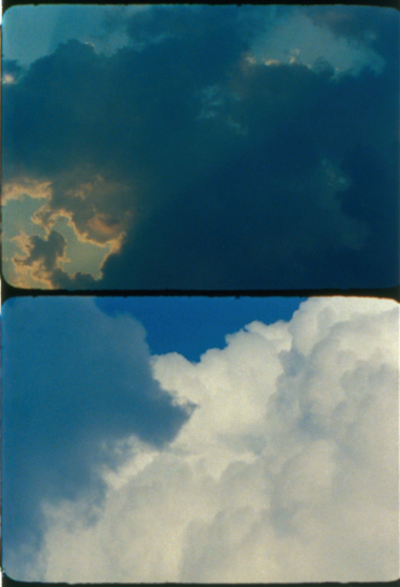
O'er the Land / Deborah Stratman
JP: I’m actually working on a project like that with someone right now.
DS: You are?
JP: We’re not speaking about what we’re doing we’re just passing this tape back and forth.
DS: So what do you film?
JP: It’s becoming very much about performance and space, actions and reactions. We’re documenting micro-events we’re each doing.
DS: Do you feel like when you have that volley going back and forth, and you receive the other person’s time block that you then create something in response?
JP: I am doing one or the other. There are certainly ways that my new statement is connected to all the ones that came before it, or it exists because of the ones that came before.
DS: I actually did try that once before – I wouldn’t call it intellectual exactly, but it was a volley of ideas. In that instance it didn’t build up to some kind of political or social argument. It was a sequence of thoughts that led to a sentence of sorts. And I’ve done something similar with writers, like with my poet friend Jen Hofer. We volleyed back and forth three sentences a day, responding to each other. People are more facile with that. We’re used to using words, and it’s just faster, language is quick.
JP: That’s helpful, I’m glad to hear you explain a little more about the “work” images do, and sound, and whatever it is that’s not language based.
DS: I think it’s because of my experience of cinema. In my formative years, before I became a filmmaker, I wasn’t keyed into plot and narrative. I mean I love reading, it’s not like I don’t get plot and narrative, but I’m just not a natural storyteller. I contemplate stuff. I think critically about things. Part of my practice comes from thinking that I can provoke other people to start critically engaging and joining ideas without necessarily following a typical linear format.
JP: That leads me to another question. You talked about duration and editing, holding a shot for what feels like an extended period of time, but then hitting people with the next shot that is so different for whatever reason or lines up in a jarring way. I see that happening over and over in what you do, it’s part of the stress and joy of watching your films.
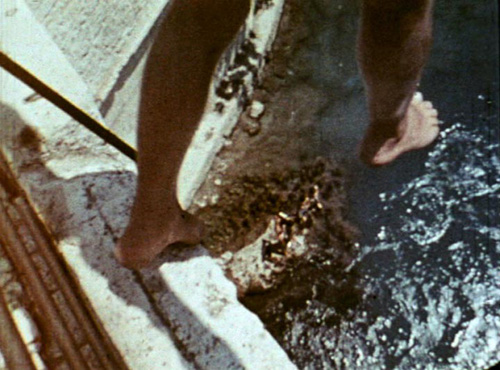
O'er the Land / Deborah Stratman
DS: For sure, that’s in some films more than others. When you can confound people’s expectations or logic, then they have to reassess and ask, “Wait a minute, what is she actually trying to say?” The confounding moment doesn’t always have to come after a block of shots with long durations. It’s not that I want to make people squirm, but it’s become rare for people to experience durational shots; for young people especially who love the frenetic barrage. I like the kind of looking that gives you space to think through it. My attraction to duration has everything to do with wanting to build up pressure. Tarkovsky talks about editing that way and I completely agree with him. Each sequence, each shot, has its own internal rhythm that’s suggesting something, and you can subvert that or you can exasperate that; you can go along with the rhythm, or you can make it five times longer, or you can give people barely anything. I like invoking the native rhythm an image suggests, and then not allowing the viewer to have it. I want people to question the motivation behind shot lengths. Playing with temporal expectations is what is most indigenous to cinema. And maybe indigenous to other kinds of thinking, I don’t know. Where you’re forcing someone to stay longer or shorter with something than they expect. That’s what I love most about cinema – manipulating the temporal plane.
JP: I would love it if you could talk more about editing, duration, time, and that kind of sculptural thinking.
DS: I could never edit without sound. Sound completely changes your sense of how quickly time passes. Betzy Bromberg once told me she likes to edit without sound and then add it later. How do you know how long anything should be? For me, as soon as sound is added it suggests a totally different length for a shot.
I like to work with index cards, especially when I’m editing 16mm film. I write a few words that describe what that shot is so that I can shuffle them around and think about what this concept does next to that one and so on, in a shorthand way. Sometimes I just go away from the editing table and work with the cards. Often that’s when I realize I’m missing something, and then I’ll go shoot more footage to deal with that hole. I would say that’s true for the more essayistic films, but not for more event driven films like Kings of the Sky (2004) or The BLVD (1999). In those instances, it’s more about foraging. Not thinking so much just collecting, collecting, collecting and then much later returning to the footage. I don’t go back and re-shoot in those films, the shooting and the editing are much more separate.
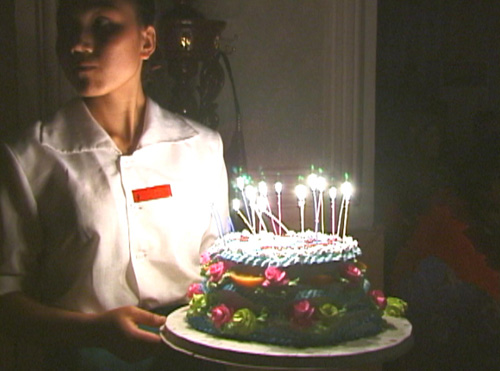
Kings of the Sky / Deborah Stratman
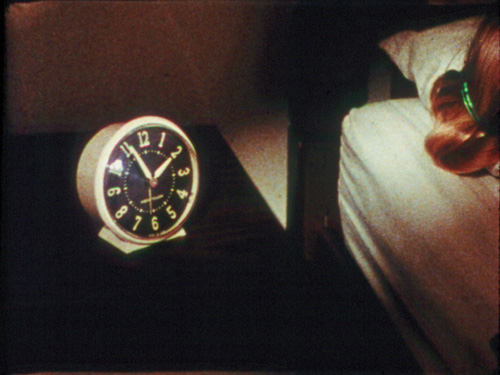
In Order Not to Be Here / Deborah Stratman
With films like O’er the Land or In Order Not to be Here (2002), the process is much slower, more deliberate. I will see a gap, I’ll go get footage to fill it, I’ll add it in — building the structure while I shoot. Whereas in other films, I shoot everything during a very limited chunk of time and I never go back and shoot more. I edit those films almost like it’s someone else’s footage. I usually wait a long time before I edit, to separate myself from the material. If a shot was really hard to get I’ll think, “I can’t take it out! It was such a pain in the ass to get!” Whereas if I wait a while, I won’t feel so attached and it’s easier to give up.
JP: I found it interesting when you mentioned that some other image could be in the place of another image in your films. I had imagined that all of your works were created similarly, in this documentary style of gathering material and working with what you acquire. It made me wonder what that means when one image could be switched out for another.
DS: It definitely depends on the type of project. Some are a process of finding the film that’s in the footage, and others are about moving towards a specific film. The essay films feel more sculptural in the sense of adding stuff to build it up – it’s cumulative; whereas the documentaries are more of a negative [subtractive] process – you’ve got this big block and you carve away at it. I guess what I mean when I say one image could be switched out for another is that when I sense a gap, I often don’t know what will alleviate it, and a lot of images could potentially, and successfully, fill that hole.
JP: I have been thinking about narrative elements in your work. I had initially thought she’s not working in typical narrative forms, but then I realized that story elements do play a role at times. I found the way you use text and narration to be very interesting.
DS: I’d be at a total impasse if someone asked me to write a narrative. I couldn’t do it. The first time I started considering narrative was when the Ann Arbor Film Festival gave one of my films an award for “Narrative Integrity.” I was surprised, as I never would have considered that film narrative. Then I thought about how amassing information and advancing an argument is a narrative. I also like excerpting from literature. Even back with On the Various Nature of Things (1995), those are excerpts from Michael Faraday’s physics lectures. And the film after that one (From Hetty to Nancy, 1997) used a lot of memoirs, letters, scientific diaries, on-screen texts… all these different narrative tropes.
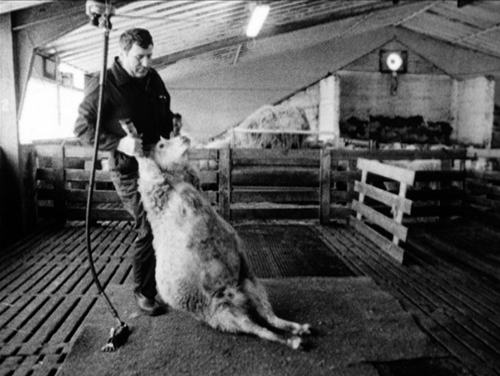
From Hetty to Nancy / Deborah Stratman
I have no problem appropriating literary trajectories. I get floored watching people adjust to the cloud sequence in O’er the Land when Colonel Rankin begins his story – their body language shifts, everyone sort of straightens up, the manner of paying attention totally changes. That’s interesting to me – the way we unconsciously shift into being more passive listeners when a story’s being told, versus the more active way we hunt for meaning when the sequence is not literary. We always prioritize understanding language. So if there is a voice-over that is kind of garbled and you can’t make it out, you will strain, to the occlusion of everything else, and focus on trying to hear that voice-over. Whereas if you can hear it clearly, you can relax and pay attention to other things. I want to work with these different ways that we pay attention. I feel like if you use just one way, then people get lazy or burnt out, but I want to keep their attention. So I play with that edge – when they start to get comfortable with one kind of attentiveness, I flip them into another. What’s easier for some people is harder for someone else. I use narrative in a more strategic way, so I can start using a different part of my brain. Maybe someday I’ll work on something that’s more out-and-out narrative.
JP: I was enjoying picking out narrative as a strategy in your works.
DS: In From Hetty to Nancy, the narrative information is all derived from letters. It’s different from interviewing someone, which I also really like to do. Interviewing is a more present, less reflective state. And that goes back to the attention thing – I like to mix it up and use more than one strategy. I don’t want all Great Plains. Let’s also have some mountains.
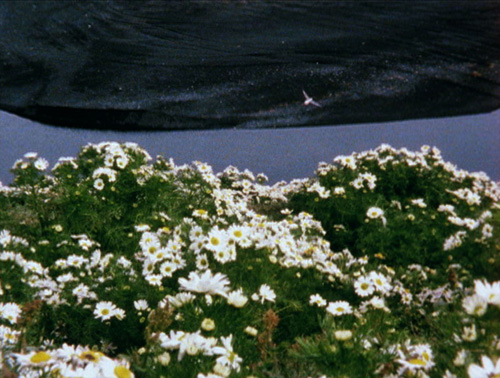
From Hetty to Nancy / Deborah Stratman
JP: In thinking about Hetty to Nancy, I’ve wondered why epistolary novels were popular at a certain time period. I’ve also been wondering about the kind of listening that’s engaged in that moment – it’s kind of voyeuristic. I suppose we call that eavesdropping. It’s interesting to use that material, when a letter is intended for an intimate audience, when something so private is made public.
DS: Hetty to Nancy is even more complicated because I think those are fake letters. I think Louis MacNeice, who was Auden’s lover at the time, wrote the letters pretending he was Hetty, and used the letters as a kind of relational allegory. These guys were commissioned by some British publisher to write a travelogue about Iceland. So what they did was collect Icelandic stories and interviews, scientific data and letters and poems, in addition to generating their own poems and prose. I can’t remember now if there was something in the titling that made me guess they were fabricated letters, but I kind of loved the suspicion. What’s behind wanting to have a false set of letters? To seduce a reader with the story? And what does that have to do with peeping into a private exchange?
I went to this program at Oberhausen [Film Festival], last May, where they had this incredible program called “From the Vaults:” 10 programs, each with 15 films or more, all of them from 1902-1920. Not knowing much about early cinema, I was so surprised by how expansive it was. I’d always thought that back then people had one conception of cinema, that it was theatrical. But these programs showed every mode you can imagine, from experimental to documentary to narrative to journalistic to performance art to special effects. It was all in there from the very beginning. You can’t say cinema aspires toward the narrative. That happened later. In the beginning it was like “anything goes!”
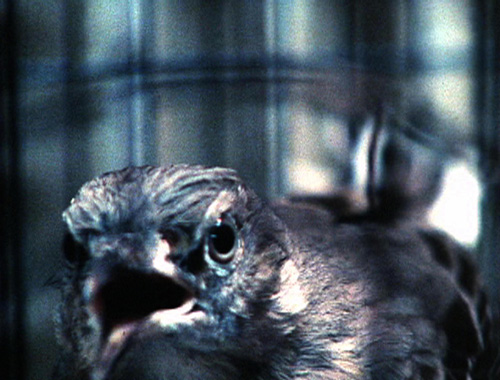
O'er the Land / Deborah Stratman
JP: I sometimes describe O’er the Land and other films of yours as “droney,” which I mean as a wonderful compliment. Sound is so important; I have a sonic experience with your films. They can really blow out speakers and be awesome. It’s great. Do you think of your work like music or sound? How do you think of sound in your films?
DS: Maybe I will say that… “I make drone films.” I do love electronic, atmospheric, non-narrative music. It’s music that’s about volume and pressure and not about “here’s a melody, let’s follow it.” I appreciate that tonal type of communication. I also really, really love that sound is half the film. I think a lot of filmmakers use that to the nth degree but plenty don’t. A lot of audiences aren’t used to being as worked by the soundtrack as they are by the image. It’s not my intention, although sometimes I feel like it’s the effect, that these films turn out kind of operatic. I get so excited by that over-the-top sound that they become more operatic than I intended. A lot of problem solving can be done with the soundtrack. Lots of makers, from Robert Bresson to Walter Murch have used sound subversively in really different ways, and so intelligently, to do what the image can’t convey. Sound can create not just tone and mood but environment.
Michel Chion, the sonic theorist, talks about degrees of spatial extension, and how sound can convey scale from extreme intimacy, like what’s inside one person’s head, to vast expansion for miles and miles around. In terms of spatial construction, the way sound can do that is so much more facile than how an image can. We bring such sophistication to how we watch films, we’re trained to visually break them down, but not so much to the soundtrack. Filmmakers should take advantage of that lack of critical attention. I like being sonically manipulated. I like being carried away in that current, that sonic bath, and so, I want to give a little back.
JP: Especially during the Colonel Rankin story in O’er the Land, it has that incredible building tone –
DS: The Shepard tone!
JP: Yeah! Yeah!
DS: Those are so cool psychologically because they feel infinite, like they’re going up up up, but it’s always the same octave. It’s just one rising tone that, when it reaches a note one octave up, mixes with the lower octave so it feels like it is permanently accelerating and ascending (or decelerating and descending). My friend Steve Rowell was working with those and I thought, “Oh my god, that’s such a cool manipulative phenomenon – a constant feeling of falling, but also of building tension.”
JP: I have heard that that type of tone has been linked to a sort of fascistic control of people – like, how on a dance floor, this sound keeps you moving forever.
DS: It is a kind of Pavlovian propulsion; it’s super physiological. In In Order Not to Be Here, there’s that scene where the guy is running and it still makes my heart beat fast. Images don’t do that for me. They don’t affect me physically. If I get to know a set of images really well they stop being affective. But sound makes my heartbeat rise even if I’ve heard something hundreds of times. If that’s half of what you’re doing as a filmmaker it’s an amazing tool.
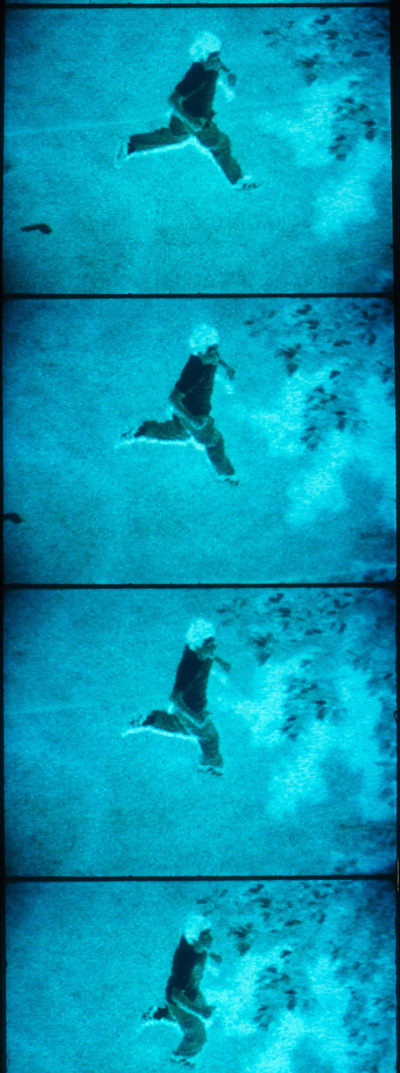
In Order Not to Be Here / Deborah Stratman
Published December 5, 2011
ABOUT THE AUTHOR
Julie Perini is a film/video artist living in Portland, Oregon. Her video work has exhibited widely at national and international venues. Publishers and periodicals including A.K. Press, Afterimage, and Incite have published her writing on performance, film, video, art and politics. Perini has been involved with collaborative initiatives that promote independent media, community cultural production, and progressive social change. She is Assistant Professor of Video Art/Time-based Media at Portland State University. Find out more at julieperini.org
INCITE Journal of Experimental Media
Back and Forth
